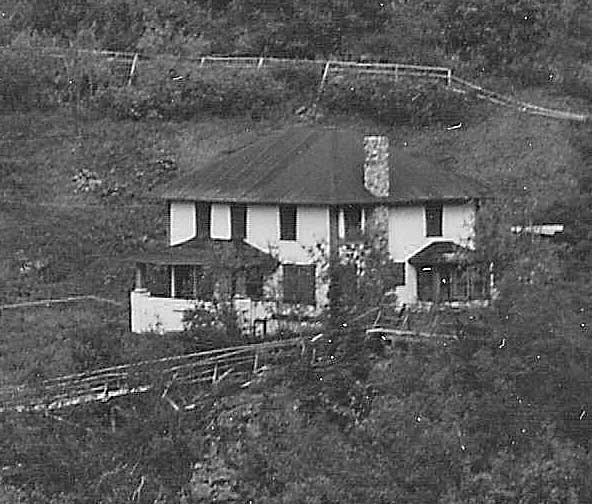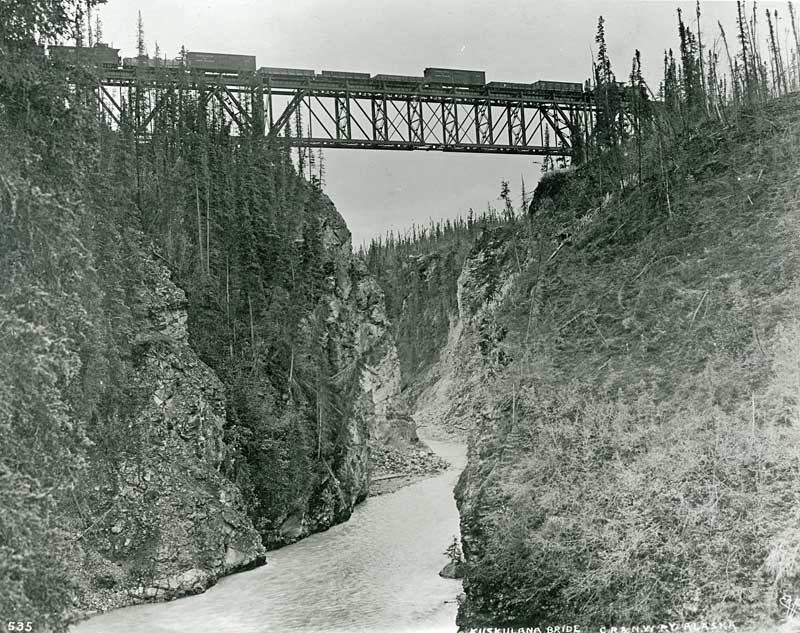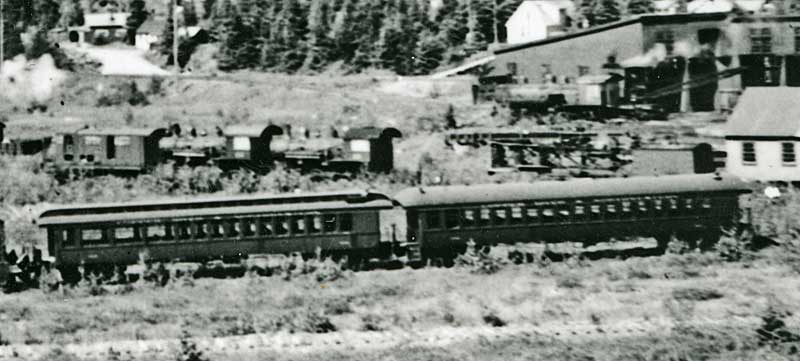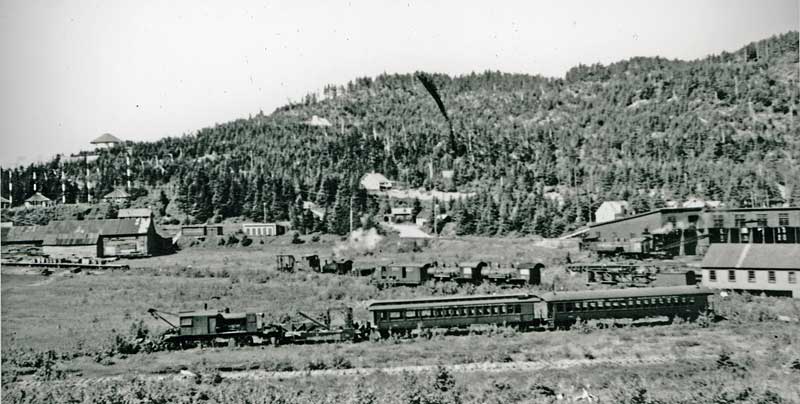How many times had Stephen Birch made this trip on
this, the premier symbol of his power and influence in Alaska, the
Copper River and Northwestern Railway? This railroad was undeniable
proof that it was possible to overcome the harshest of obstacles in the
wilderness which was Alaska, given enough persistence and money.
Kennecott the mine system is where Stephen began his rise to chairman of
the board of Kennecott the corporation. It started as the Bonanza
Mine--the personal project of Stephen in the days when he was just a
mining engineer. It was a rapid rise from geologist to company
president.
|
 | |

| |
| | | | |
|
Stephen Birch,
1872-1940, founder & chairman of the board of directors of
Kennecott; president & director of Alaska Steamship Co.;
chairman of the board of directors of Braden Copper, Chile;
director of the Alaska Development & Mineral Company, the
Bankers Trust Company of New York, the Chicago, Burlington &
Quincy Railroad Company, the Colorado & Southern Railway
Company, and the Northern Pacific Railway Company.
| | Daniel Cowan
Jackling (August 14, 1869 - March 13, 1956), was an American
mining and metallurgical engineer who pioneered the exploitation
of low-grade porphyry copper ores at the Bingham Canyon Mine,
Utah. | |
| | | | |
The promising outcropping was optimistically named the Bonanza at a time
when the mine was still of unproven value. The Bonanza developed into an
unbelievably rich lode which more than lived up to its name. The
chalcocite outcropping proved to be a very small indicator of fabulously
rich copper veins extending miles into the Bonanza Ridge. The Bonanza,
Jumbo, Motherlode, Erie and the Glacier mines together amounted to the
greatest high grade copper lode ever developed.
The Guggenheim money and that of other rich investors which was behind
the Alaska Syndicate had also picked up substantial interests in a
number of large lower grade copper mines. The greatest of these was the
Utah Copper Company’s open pit mine, developed with innovative
technology brought in by Daniel Jackling. It was the largest single
copper producer in the world when Kennecott Corporation formed in 1915.
Then came the Ray, Chino and Ely Mines in the southwest. These mines,
and the even larger Braden Mine in Chile, long ago took over as the
mainstays of a company which had its origins in Alaska and which had
even derived its name from the remote Kennicott Glacier. |
|
 | |
 | |
|
Kennecott
Copper Company's Bingham Canyon Mine, c 1935 | |
KCC's Braden
Mine, Sewell, Chile, 1938 | |
| | | | |
| Someday the historians who
write about us will undoubtedly deem our spelling of the company
a mistake. We don’t make those kind of mistakes. I knew what I
was doing. Kennecott is not Kennicott. We are much more than
that. | |
View of the Chitina trestle
looking west toward Chitina from Kotsina Hill
Birch watched through the rear observation window as the consist cleared
Kotsina hill. It passed the small line shack to the south and the long
siding to the north as it began picking up speed at the top of the ridge
on the relatively flat stretch with long, straight runs that would
enable the train to push toward seventy miles per hour as it approached
Strelna. He saw the deep Chitina River valley disappear from view behind
the train. The whistle ahead began blowing to alert anyone along the
tracks of the high-speed private train roaring through the area.
| Kennecott no longer needs
Alaska, though our interior mines have remained productive well
beyond our expectations. My Alaskan operations financed our
corporation’s purchases. But now it’s time to move on and leave
Alaska behind. We can’t live in the past and run old mines and
railroads for nothing. | |
Birch had not made a visit to Alaska since 1916. That was the interior
mine’s greatest production year. It was also the year in which Stephen
and Mary were wed. In those early days Kennecott was considered the
centerpiece of the corporation which carried the same name. Birch wanted
to show off the magnificence of the territory to his new bride. He
planned the honeymoon trip in great and lavish detail. But Mary was
thoroughly unimpressed. It mattered not that he had two special private
railroad cars made up for the trip. Nor did it impress her that Alaska
Steamship, which was owned by Kennecott, made one vast ornate stateroom
out of five standard ones just for the special couple on the S.S.
Mariposa. The next year the Mariposa wrecked. This final disaster seemed
to Birch to be a fitting conclusion to an apparently jinxed trip.
Stephen Birch had been particularly proud of the honeymoon cottage he
told E.T. Stannard to build for Mary and him at Kennecott. This
four-bedroom two-story house with its library-office and combination
living and dining room also had a well equipped modern kitchen attached.
Not that the guests would ever have to use it. The company provided one
of its senior cooks to prepare and serve the meals in that special
kitchen.
The most distinguishing feature of this special residence was its unique
fireplace which was built of stunning copper ore. Then there was that
wide veranda which overlooked the Kennicott Glacier as well as all of
Kennecott’s staff row.

|
Stephen Birch
House / Guest House at Kennecott, c. 1946 (site already
abandoned). --W.A. Richelsen photo |
E.T. Stannard saw to it that the place was fully furnished with posh
furniture right down to the player piano. He stocked the residence with
expensive alcoholic beverages and cigars for the special guests, though
alcohol was not allowed elsewhere on the site, except at the
superintendent’s residence.
Stephen was not the only visitor to use this comfortable residence with
the commanding castle-like view. To justify the high cost of
constructing it, the place was designated for use by any distinguished
company official or special guest of Kennecott. It became known as the
Stephen Birch guest cottage.
| If Mary had only
appreciated what we had done for her--the special private train
car I’m riding now, the walls we had to tear down on the
Mariposa to make that huge stateroom, the guest house at
Kennecott. Oh well. | |
Stephen sighed at the thought. After that 1916 honeymoon fiasco, he lost
his enthusiasm for Alaska.
| Mary, you ruined it for
me, I hope you know what I gave up for you. I haven’t been here
since. This will definitely be the last time. I’m getting too
involved in more important matters than to use up much of my
time on these remote Alaska trips. To think I used to look
forward to the opportunity to get in some trophy hunting here,
but no more of that. I ‘m getting along in age now. I don’t know
if Mary tamed me, or if I have just lost my spark of enthusiasm.
It seemed I used to get a lot more enjoyment out of these trips
than I am now. | |
| |

| | |
|
|
Strelna in
the early 1920s, Dwyer's Inn on left. --Candy Waugaman | | |
| |
Kuskulana
steel bridge, MP 144 --Museum of History
& Industry | | |
|
|

| | |
| | | |
|
About that time the train whistle indicated that Strelna was
approaching. This had been Stephen’s favorite place to start out on a
nice week of mountain sheep hunting. Dwyer’s was still a rich man’s game
hunting lodge.
| Dwyer’s Inn, what a great
place! Guess I’ll never see the inside of that lodge again. I’ll
probably never see another mountain goat again except as a
stuffed head. My trophy-hunting days are over if I can’t hunt in
Alaska. | |
The whistle blasted in a continuous loud series as the private train
roared past Strelna on its nonstop run to McCarthy.
| I was the one who first
breathed life into Kennecott. Even Kennecott as a world-class
corporation was really my own design. Now I finally return to
where it all started. I brought it to life and now I will write
the epitaph. | |
Several railroad workers at Strelna looked up at the private train in
surprise. The train was an unannounced special. It was not stopping. It
was not even slowing down. All the trains stopped at Strelna, but not
this one. It was a very large engine pulling a combine and a business
car. The Strelna crew shrugged and went back to their jobs.
| It’s easy enough to
rationalize. Those copper mines are done. I’m only here to place
the official stamp on what we all know to be true. Problem is
that when we leave we take everything with us, the whole
lifeline of the valley. I kill the mine and it follows that I
kill this railroad. That’s the death knell of this area for
sure. Who could really live here for long without this train
system we built? | |
Stephen saw part of the crew picking up rails as his car whizzed by.
They were all Indians.
| If Nicolai were still
alive he’d probably be delighted-- knowing what is about to
happen. I guess many of his people--especially the older ones
who remember the way things were before we built our
railroad--will probably applaud us leaving. | |
Dwyer’s Inn and the water tower grew small as the train rushed toward
Kuskulana Gorge. To the south Stephen spotted an Indian graveyard.
| I know we will hurt them
too. They have become almost as dependent on us as the
townspeople of McCarthy and Chitina. The whites will simply pack
up and leave. As for the Indians, they’ll remain. This is their
home. Not ours. It’s likely to be a nasty life. Do they even
care? Maybe not. Perhaps this will be the right thing for them
after all. I don’t know. I just know it will happen anyway.
Whether it is I who do the dirty deed or someone else, the end
is coming. I just happen to have the dubious honor of being the
one who kills the valley’s lifeline. | |
Birch leaned back in his seat. His eyes were closed as he contemplated
the implications of his trip. He chuckled to himself.
| I guess this means no
plaque or statue in my honor up here. Not that many here in
Alaska even know I exist. Oh well, neither fame nor infamy has
ever been much of a motivator for me. I sure miss old Nicolai.
Now there was a self-effacing guy who really mattered. Things
just aren’t the same anymore. I feel like just another relic of
the old days just being up here in this old railroad business
car out in the middle of this wilderness I used to walk so many
years ago. | |
Daniel Jackling entered from his private room near the front of private
car 100, now joining Stephen Birch . Jackling served as the head of the
operating committee for the corporation. He had come on board the
corporation as the genius behind the development of the enormous
low-grade ore Utah Copper mine. Jackling once had a financial interest
in a mining concern in Juneau. He contributed the design layout for an
almost revolutionary mill for the now defunct Gastineau Mine. As he was
fond of saying, “You can’t pick a winner every time.”
Birch was delighted to have this great engineer along to assist in the
very last high level on-site evaluation of the mine. Jackling was one of
the Kennecott directors. He was unequaled in his understanding of the
copper industry, excluding Stephen Birch himself. Dan was not in the
same rush as Stephen to close out the Alaskan operations. In the end, it
would be his view which would prevail. For many years there would be
considerable disagreement on the board as to the best time to close the
operation. Birch would finally escape the matter when he retired from
the presidency in favor of E.T. Stannard, who harbored no special
sentimental feeling for Alaska and would have no problem ordering a
final and abrupt closure when that time came.
|
|
|
|
|
|

|
|

|
|
|
The Kennecott observation car,
no. 100, used by Stephen Birch on more than one occasion
awaits an uncertain fate in the abandoned railroad yard at
Cordova in 1943. No. 100 is on the left. Day coach No. 101
is on the right. --Cordova Museum |
|
|
|
|
|
|
|
|
|
|
|
|
|
|
|
|
The Kennecott was no longer the opulent private car it had once been
when it was specially fitted for that 1916 honeymoon trip. The
observation and dining car was now fitted for general public use. Those
who wanted to dine and enjoy the relative luxury of riding this car for
a price could now do so. During the July 4th Special Run, it was always
one of four or five cars on the annual passenger consist which hauled a
large part of the valley up to McCarthy and back for the annual softball
playoff and the other special events. Several of the more lavish
features had been eliminated, yet it was still quite the extravagant
ride for those who were so lucky as to travel on her.
When Warren G. Harding came through Cordova in late July of 1923, just
before his untimely demise in San Francisco, his Presidential party used
this car. There was no further reason to keep what had once been
Stephen’s business car for exclusive private use. Superintendent Hanson
preferred running his own specially fitted Studebaker over the rails for
his personal inspection trips rather than use the large business car.
This would be the last time the Kennecott would ever again be pulled off
the line for visiting high-ranking officials.
|
No comments:
Post a Comment